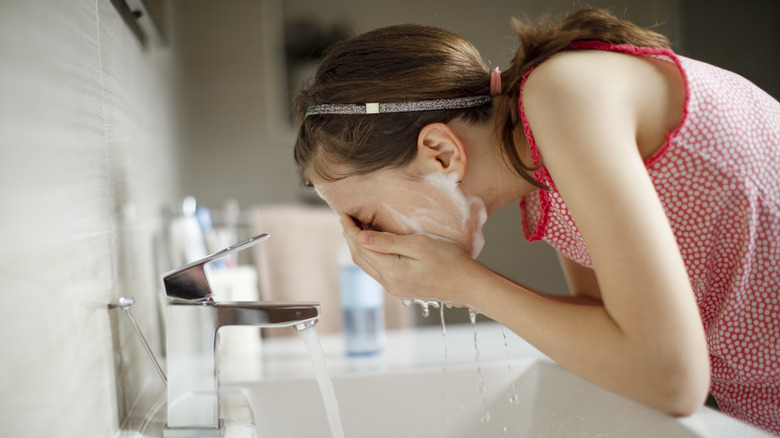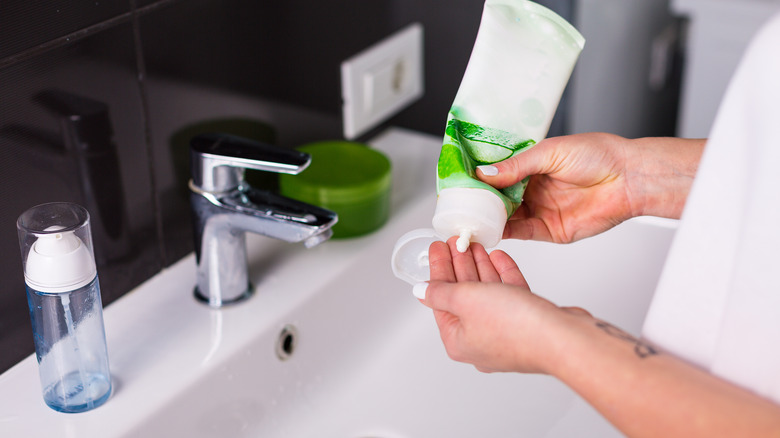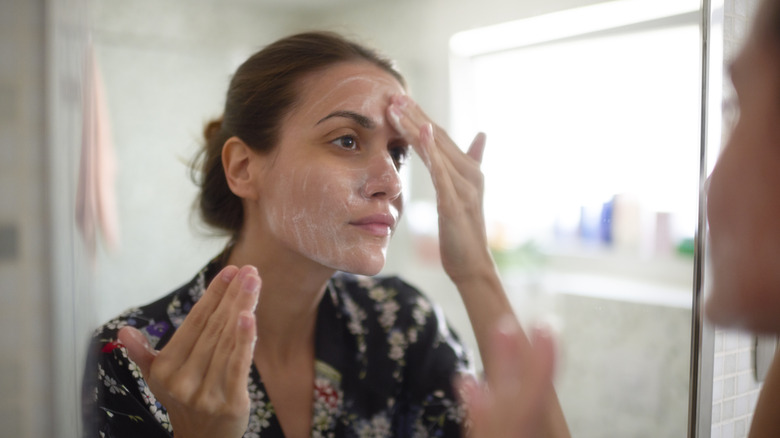The Face Washing Mistake You Should Avoid At All Costs
Given that most of us wash our face every day, it would be fair to assume that we know what we are doing, right? Well, according to TikTok (and dermatologists), many of us might actually be making a huge mistake when it comes to cleaning our skin. The new trend claims that before washing your face, you are first supposed to emulsify the facial cleanser in your hands.
Christina Huang, MD, the chief dermatology resident at the University of Toronto explained to Well+Good, "Emulsification is when you mix two different ingredients. With facial cleansers, you're mixing a gel-based or an oil-based cleanser with water, and [...] that emulsification process improves the cleaner's effectiveness and enhances the distribution of active ingredients." The simple act of rubbing your cleanser into a foamy lather before applying it to your skin sounds simple enough but can apparently make a huge difference to your beauty routine.
While this revelation has obviously taken off on TikTok (with the emulsification hack even being applied to the shampoo process) you might be wondering if it's really worth trying out. Can emulsifying your facial cleanser really lead to healthier-looking skin? And what about different types of cleansers (like, for instance, if you have a different day and night cleanser)? Let's dive into emulsifying and see if this latest trend is really all that it's cracked up to be.
Why emulsifying can be important
Dr. Huang explained to Well + Good why emulsification can change your face-washing game, "When the cleanser is emulsified, that texture can penetrate deeper into the pores and provide a more thorough cleaning experience." While clean skin does not necessarily preclude the development of acne and/or blemishes, it can definitely make a huge difference (especially for your pores). This is especially true if you regularly wear makeup products on your skin. If not properly washed off, leftover makeup residue can lead to clogged pores, bacteria, and breakouts.
Dr. Huang also mentioned that emulsifying can make your cleanser easier to remove as well, "Because it's emulsified, it will pick up water better, so therefore, when you're rinsing it off, it can also be cleaned off and rinsed off more easily so you don't leave any debris from your cleansers or anything else you're applying on your face that can further contribute to acne, breakouts, and pimples." Making sure to remove all of your cleanser can be just as important as removing your makeup when it comes to keeping your face breakout-free. This is particularly important for those who use oil-based cleansers since the same process that makes your oil cleanser so effective at removing makeup and products can also trap bacteria on your skin if it's left on for an extended period of time.
Is emulsifying all it's cracked up to be?
It's important to mention that there is some debate amongst dermatologists as to whether this emulsification process truly leads to better end results. Dr. Sabina Hanoman-Singh, a skin expert and aesthetic doctor, told Refinery29 that while emulsifying definitely enhances the spreadability of your cleansing product, it's less clear if there are tangible benefits from that process. "Whether you foam [your cleanser] or you don't, it still contains the same amount of cleansing substances," she explained. With that being said, the effectiveness of your personal facial washing technique can depend largely on the type of cleanser you use and even the method of application you prefer (hands, washcloth, facial tool, etc.).
Equally important to note is that the process of emulsifying is essentially the reaction of certain ingredients (surfactants) with water. This reaction produces gas bubbles in your gel or liquid cleanser that creates a foam. However, foam might not necessarily be the best option for all skin types – namely those with dry or sensitive skin. So, while this TikTok trend might definitely be worth trying, especially if you're struggling to feel truly clean after washing, make sure you take it with a grain of salt. As always, it's important to see for yourself if you notice a difference.


